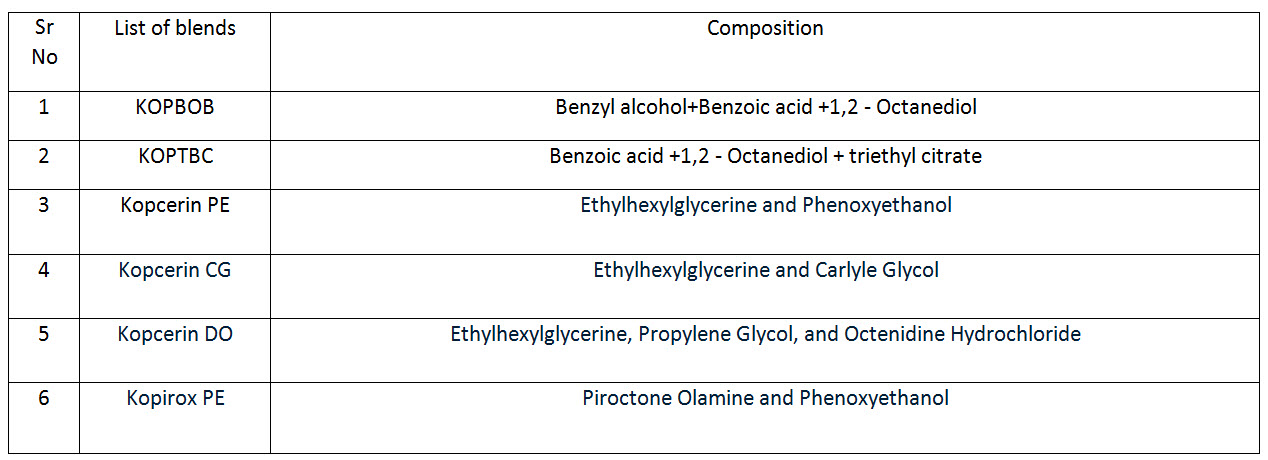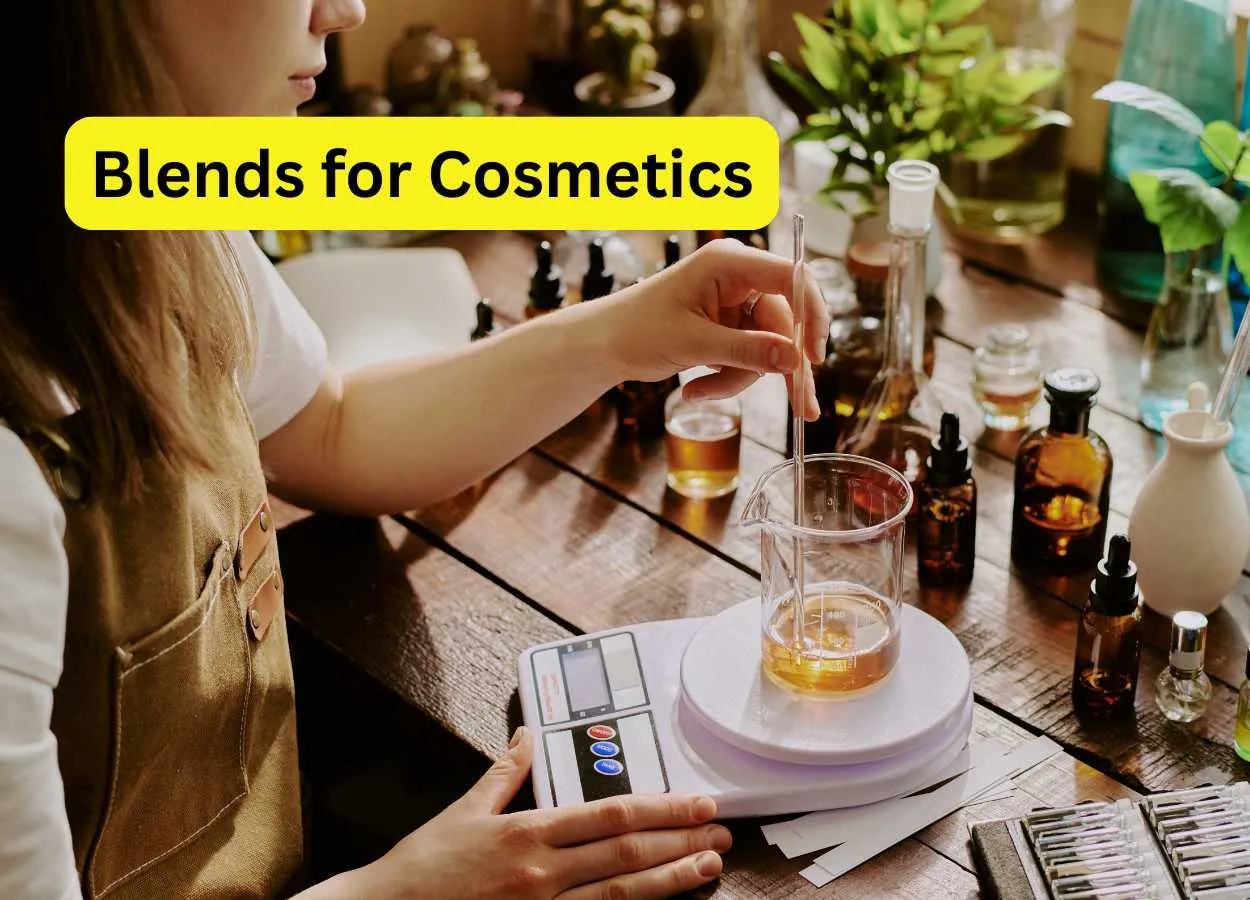 Vinay Kumar Singh.
Vinay Kumar Singh.
Head-Formulation
Kumar Organic Products Research Centre Pvt. Ltd.,
Bengaluru
Email : formulation_krc@kopresearchcentre.net
In the context of ingredients, a "blend" refers to a mixture of two or more components,that are combined to create a finished product. This process involves mixing ingredients together, usually with a mixer or machine, ensuring homogeneous integration of ingredients, creating consistent and stable formulations. We at Formulation Dept. of Kumar organic Research Centre develop & create Blends, which are as below.
Emulsifier BlendsAn emulsifier blend is a mixture of two or more emulsifiers used to achieve specific functionality in an emulsion. These blends can be tailored to optimize stability, viscosity, and other properties of the emulsion, such as those found in cosmetics, food products.
Benefits of Emulsifier Blends :
• Improved stability :
Blends can provide more robust and long-lasting emulsions.
• Customizable properties :
Different combinations can tailor the viscosity, texture, and other characteristics of the emulsion.
• Reduced reliance on single emulsifiers :
Blends can overcome limitations of individual emulsifiers, such as toxicity or instability.
• Synergistic effects :
Some combinations can produce properties that exceed those of their individual components.
Emulsifier Blends of Kumar Organic
Kopemulsi
Kopmulse
Preservative Blends
Cosmetic Preservative Blends are the mixtures or blends of more than one preservative compound in order to inhibit the growth of microorganism on cosmetic products. Cosmetic Preservative Blends are the mixtures or blends of more than one preservative compound in order to inhibit the growth of microorganism on cosmetic products. Presence of water and nutrients in Cosmetic products can easily support the proliferation of microorganisms. Apart from this reason, the microorganism is also the cause of change in viscosity and colour in cosmetic products.
Therefore, the requirement to check and control microbial activity plays a vital role which results in increasing the shelf lives as well as the quality of the products.
Cosmetic preservative blends also offer broad spectrum with a significantly lower level of its use in final products which result in seeking its attention by various personal care industries.

Benefit of Preservative Blends
• Increased Shelf Life :
Preservatives significantly prolong the period a product can be stored and used without compromising its quality or safety.
• Protection from Microorganisms:
They effectively inhibit the growth of bacteria, yeast, and mold, preventing spoilage and contamination.
• Safety for Consumers:
By preventing microbial growth, preservatives reduce the risk of foodborne illnesses and ensure the product is safe for consumption.
• Ingredient Stability:
Preservatives can help prevent reactions between ingredients that could lead to deterioration or loss of effectiveness.
• Maintain Quality:
They help maintain the desired texture, color, and other sensory properties of the product.
Broad Spectrum Protection:
Blends are often formulated to provide protection against a wide range of microorganisms, ensuring comprehensive protection.
Kumar Organic has developed above Preservative Blends having its own unique attributes.
Antioxidants : Protect ingredients and the skin from damage. Antioxidants can help slow down the aging process by reducing oxidative stress. Antioxidant blends offer numerous benefits by combating oxidative stress and free radicals
Surfactants: Help create foams and cleanses. acts as surface-active agents, lowering surface tension, and improving the mixing of immiscible liquids. They are used in various formulations to enhance their properties, such as emulsifying, foaming, and wetting.
Benefits of Surfactants in Blends :
1. Emulsification and Stabilization :
Surfactants, with their unique structure of both hydrophilic and hydrophobic parts, enable the blending of water and oil or other immiscible liquids. They stabilize these emulsions, preventing separation and maintaining a homogeneous mixture.
2. Foaming and Wetting:
Surfactants reduce surface tension, facilitating foam formation and improving the wetting power of liquids. This is important in cleaning products, cosmetics, and other formulations where these properties are desired.
3. Cleaning and Dispersing:
Surfactants can trap dirt and oil and lift them from surfaces, allowing them to be washed away with water. They also help disperse solids in liquids, improving the clarity and consistency of formulations.
4. Mildness and Compatibility:
Surfactants can be designed to be gentle on skin and materials, reducing irritation potential and improving compatibility with other ingredients in a blend.
5. Controlled Foaming:
Surfactants can be tailored to control the amount and type of foam produced, ensuring optimal performance and user experience.
6. Wetting Agents:
Surfactants enhance the ability of a liquid to spread over a surface, making it easier to apply and distribute.
Fragrance blends : Combining different essential oils or other fragrance ingredients to create unique scents. This is required when any single fragrance is unable to mask base note. Fragrances blends, whether natural or synthetic, offer a multitude of benefits, enhancing the sensory experience and influencing mood, memory, and product appeal. They can evoke emotions, mask unpleasant odors, and even create a signature scent for a brand.
Benefits of Fragrance Blend :
1. Sensory Enhancement and Mood Regulation:
• Fragrances can trigger specific emotions and memories, affecting mood.
• Certain scents, like lavender, can promote relaxation, while others, like citrus, can energize and uplift.
• The sense of smell is strongly linked to the brain, directly influencing mood and well-being.
2. Masking Unpleasant Odors:
• Many cosmetic and personal care products have ingredients that can emit unpleasant odors.
• Fragrance can effectively mask these odors, making the product more appealing and enjoyable to use.
3. Brand Identity and Recognition:
• A signature scent can become synonymous with a brand, promoting recognition and building customer loyalty.
• Consumers often associate a particular scent with a product, strengthening the brand image.
4. Emotional Connection and Personal Expression:
• Fragrances can elicit memories and emotions, creating a strong emotional bond between the consumer and the product.
• Fragrances allow users to express their individuality and preferences through scent.
5. Enhanced Perception and Satisfaction:
• A pleasant fragrance can lead users to perceive a product as more effective, potentially boosting customer satisfaction.
• This "placebo effect" can create a more positive overall experience.
6. Versatility and Customization:
• Fragrances can be used in a wide range of products, from cosmetics and personal care to household cleaners.
• The ability to mix different fragrance oils or use synthetic fragrances allows for customization and unique scent profiles.
Pigment blends: Combining different pigments to create desired colours. This is particularly useful in Colour cosmetics. Pigments offer several benefits when blended in various applications, including enhanced color vibrancy, opacity, and stability. They also contribute to improved tinting strength, resistance to environmental factors, and can even offer health benefits in specific contexts like food and cosmetics.
Benefit of Pigment Blends :
• Vibrant and Opacity :
Pigments allow for creating rich, opaque colors with a wider range of shades, offering more creative flexibility in artistic expression and product formulation.
• Tinting Strength :
Pigments improve the ability of a medium (like paint or ink) to change the color of a base color, making it easier to create desired shades.
• Undertones and Shades:
When blended, pigments reveal subtle undertones and shades, enabling the creation of nuanced and complex colors.
2. Enhanced Durability and Stability :
• Resistant to Degradation:
Pigments are generally resistant to light, weathering, heat, and chemical exposure, ensuring long-lasting color vibrancy and stability.
• Reduced Color Migration:
Pigments can help minimize the migration of color between different components of a blend, leading to a more consistent and stable final product.
3. Specific Applications and Benefits :
• Digital Printing :
Pigment inks in digital textile printing offer advantages like compatibility with blended fabrics, reduced carbon footprint, and improved color quality.
• Cosmetics :
Pigments are crucial for adding color to cosmetics, creating a wide range of shades in products like eyeshadows, lipsticks, and nail polishes.
• Food Industry :
Natural pigments, like betalains and anthocyanins, offer vibrant colors and potential health benefits, such as antioxidant and anti-inflammatory properties.
• Skincare :
Natural pigments like those found in beetroot extract provide skincare benefits, including antioxidant protection and potential collagen support.
• Health Benefits :
Some pigments, like fucoxanthin from diatoms, have demonstrated potential health benefits, including antioxidant properties and weight loss support.
• Plant Photosynthesis :
Different pigments in plants allow them to absorb various light wavelengths, enhancing the efficiency of photosynthesis.
Silicones : Polymers that can act as moisturizers, emollients, thickeners, and emulsifiers. Silicone blends offer a range of benefits, particularly in cosmetic and textile applications. They enhance softness, flexibility, and durability, while also providing a smooth, silky feel and improving product spread ability. In hair care, silicones can smooth frizz and add shine, while in makeup, they contribute to a flawless and long-lasting finish.
Silicone comes in various forms and blends, each with unique properties and applications. Key types include liquid silicone rubber (LSR), high-consistency rubber (HCR), room temperature vulcanizing (RTV) silicones, and fluorosilicone. These blends differ in their viscosity, curing methods, and resistance to extreme conditions like temperature or chemicals.
e.g. Blend of Cyclopentasiloxane and Trimethylsiloxysilicate for cosmetic products
Benefits in Cosmetic Blends :
• Smooth, Silky Skin: Silicone gum blends are emollient, providing soft, silky skin.
• Improved Spreadability: They enhance the spreadability of formulas, making them easier to apply.
• Protective Barrier: They form a breathable, non-comedogenic protective barrier that does not clog the skin.
• Enhanced Shine and Luster: Silicones can smooth hair, leading to increased light reflection and a glossy appearance.
• Conditioning Effects: They help seal in moisture and contribute to overall hair luster and vitality.
• Long-lasting Makeup Finish: Silicone-based makeup provides a smooth, flawless, and long-lasting finish.
Benefits in Textile Blends :
• Improved Softness and Flexibility : Silicone finishing enhances textile softness, flexibility, and durability.
• Enhanced Durability : Silicone-based softeners improve tear strength and wrinkle resistance.
• Water Repellency : Some silicones impart water repellency to fabrics.
• Textile Printing and Dyeing : Silicones can be used as softeners, waterproofing agents, wrinkle finishing agents, and shrinkage finishing agents.
Other Benefits :
• Flexibility and Elasticity : Silicone elastomers are highly flexible and elastic, making them suitable for various applications.
• Thermal Stability : They can withstand a wide range of temperatures.
• Chemical Resistance : Silicones are resistant to various chemicals.
• Water Repellency and Foam Control : Silicone elastomers provide excellent water repellency and foam control.
• Non-toxic and Biocompatible : Some silicone formulations are non-toxic and biocompatible, making them suitable for sensitive applications.
• Versatility : Silicones can be used in a wide range of applications, including medical
NMF blends –Blend of various Natural Moisturising Factors/agents
Blending Naturalactive with Synthetic actives
For Synergistic effect
Blends are mixtures of ingredients used to achieve specific effects in products. These blends can include emulsifiers for stable mixtures, preservatives for product longevity, and emollients for skin softening or for any other specific attribute.









